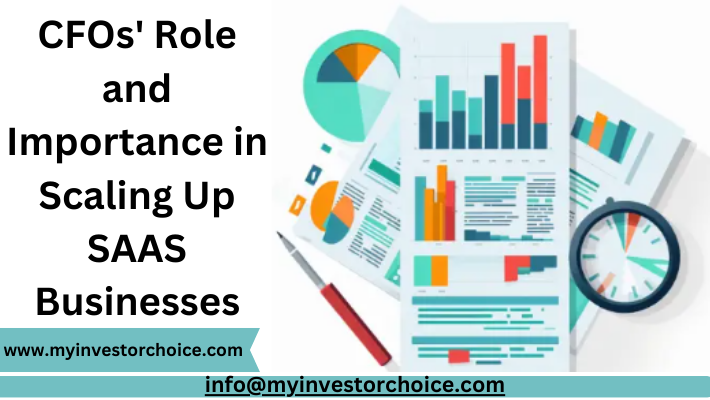CFOs’ Role and Importance in Scaling Up SAAS Businesses
SaaS CFO: who is he?
To approve, project, and report on specific development plans, the SaaS CFO is crucial. The growth strategies you choose will, however, depend on the stage of development of your SaaS company.
If you are the CFO of a new SaaS company, you may determine priorities for selecting the best product and market fit. Raising initial funding, setting up fundamental accounting systems, and identifying key SaaS indicators are your top priorities.
If your company has moved past the start-up stage, you should create a repeatable sales strategy to increase profitability and ensure future growth.
No matter where your company is, you need to be aware of its stage and how you contribute to its growth. Depending on your company’s growth stage, your SaaS chief financial officer (CFO) responsibilities may vary and alter.
SaaS CFO: What Is Their Role?

Responsibilities in Accounting
ARR (annual recurring revenue) increases accounting importance. Accountants’ duties and responsibilities cannot be undervalued.
You should pay special attention to this if your accounting firm lacks or has little SaaS experience.
Create a scalable and effective sales strategy.
SaaS companies’ CFOs should support revenue-focused sales strategies. Extreme self-control is required. Decide what works and what doesn’t and obstacles are almost certain to arise.
Implement scalable processes, ensure good unit economics, increase Series A/B investment, and monitor sales efficiency KPIs. Having scalable, repeatable, and successful sales strategies is one of the most crucial responsibilities of SaaS CFOs.
Coordinate with other departments.
CFOs of SaaS companies should work closely with divisions. Be willing to work with others. To assist the company in growing, you must understand business processes. You can only fully understand the different business activities by working with others outside your area. Know each division well. Find out how everything works to accomplish broad corporate objectives.
Investing in capital
A SaaS CFO’s responsibility is capital allocation, which is critical to the business’s success. Capital allocation will be based on budgeting priorities, strategic financial planning, and analysis. In this situation, you want to increase returns on smaller investments.
Capital funding sources and cash availability should be known. Monitor your internal investment returns, allocate resources to high-growth industries, and periodically review your capital allocation strategy.
You can pay state payroll taxes and sales-derived taxes by tracking sales taxes. Maintaining good standing with the government requires company registrations. Start a new business with a legal entity.
Increasing SaaS revenue sources.
Identifying new revenue streams and implementing scalable processes are duties of a SaaS CFO. SaaS companies are always looking for ways to increase retention rates.
As CFO, you must determine how to increase revenue opportunities. Upsells and cross-sells are revenue-growth strategies that come to mind. Creating new revenue streams requires CFOs to assess discount strategies and determine whether premiums affect working capital.
The Most Important Metrics for SaaS CFOs
The cost of goods sold (COGS)
COGS is the total expense on the income statement. Therefore, this is the first item subtracted from total income. Previously, it covered all direct labour and material costs. When it comes to actual items, the process is straightforward, but with SaaS, it can be confusing.
COGS typically ranges between 10% and 20%. SaaS companies that claim to have sold less than 10% of their products are likely to be saving money. We need to review the category again. The company may lose long-term efficiency if this issue is ignored.
Business health and success depend on COGS. In addition, it may provide information about profitability, value, and scalability.
GMV (gross merchandise volume)
Only peer-to-peer e-commerce platforms use this metric. We provide a summary of sales and site activity. Market networks and marketplaces use GMV, a non-SaaS statistic, to gauge how well or poorly the marketplace’s activity will develop.
GMV can also be used to compare historical revenue with current revenue. But it provides scant information about each item’s value even as a rudimentary statistic.
The products sold by C2C sellers may or may not be produced. Most of them are middlemen who distribute products on a commission basis. Therefore, they do not own the item up for sale.
Cost of Customer Acquisition (CAC)
Cost of customer acquisition (CAC) refers to all sales and marketing expenses associated with acquiring one new customer. Calculate for each product and channel. Salary, taxes, benefits, travel, and meals are all items on your profit and loss statement that relate to attracting new customers. Ensure headcounts and spending are recorded on the departmental ledger if not already done. It is impossible to calculate most SaaS metrics without this information.
Churn is a net negative
Churn only refers to subscribers who do not pay a monthly fee, so a negative churn rate may seem puzzling. In what way is this rate negative?
Net negative churn occurs when a SaaS company’s growth revenue from existing users exceeds its loss of existing clients.
Net Negative Churn does not consider new customers. As a result, net Negative Churn can grow even without gaining new clients.
Annual Recurring Revenue (ARR)
A business expects to earn recurring revenue from its customers by providing them with goods and services regularly. The annual recurring revenue generated by clients is predictable and recurring. Most subscription-based businesses use this metric.
Monthly recurring revenue (MRR) and annual recurring revenue (ARR) are similar. Only the adjustment period (year versus month) differs between the two measurements. ARR measures an organization’s long-term success, whereas MRR measures its rapid growth.
Both management and investors use ARR. Management can use the metric to evaluate the company’s health. ARR can also be used by CFOs to assess long-term strategies.
Is a SaaS CFO necessary?
Reduce costs and accelerate growth with a SaaS CFO
Cost savings are the primary reason to hire a CFO. A CFO will monitor spending patterns and identify expenses that are draining your budget, such as expensive procedures and underutilized software licenses.
If you have more money, you can invest more in your development. SaaS CFOs help with growth planning and strategy with actionable goals. Additionally, some fractional CFOs offer variable price options so you can scale up services as needed.
CFOs review marketing efforts and work with sales teams to expand subscription services for current customers and find new ones. In addition, they may be able to reduce acquisition costs.
Budgeting using SaaS CFO metrics
Financials are no longer confusing with the assistance of a SaaS chief financial officer (CFO). As a first step, the CFO will examine your cash flow to determine your monthly and yearly recurring revenue (MRR/ARR). Using this as a starting point, the CFO will analyze your variable income to determine its sources and forecast revenue and profit growth.
“Prediction” depends largely on the actual results of your business. As a result of the various strategies your SaaS company can employ, your CFO will have to make multiple predictions.
Despite the temptation to invest in quick expansion once product/market fit has been achieved, a SaaS CFO must first create scalable procedures and systems. Next, analyze unit economics and how customer acquisition cost (CAC), lifetime value (LTV), and attrition affect profitability and sales efficiency (Magic Number, CAC ratio). SaaS companies will have a difficult time pivoting later if they do not spend the time to perfect each of these areas before expanding.
Why is a SaaS CFO necessary?
Startup CFOs are crucial due to the CEO’s constant search for investors. Together with angel investors and venture capitalists, the CFO will develop the economic model. An interim CFO’s workload significantly decreases after funding. A quarterly review of financials and KPIs is conducted by the CFO to inform the board of this development. Investor relations, equity compensation, and venture debt are common questions.
The Changing Role of SaaS CFO

Now, CFOs are expected to do back-office work and make critical decisions. This advances the company more effectively.
Revenue recurring models have driven this transition. The full tech stack enables real-time access. Therefore, the finance department also needs to support the scalability and growth of the business.
Consumers demand more flexibility from subscription models. Subscription businesses affect the customer life cycle with every action. Business factors affect growth for today’s CFO.
To make better investment decisions, a CFO collaborates cross-functionally.
More than any other department, finance sees the entire value chain. From client interactions to back-office operations, the CFO has full visibility. By identifying operational bottlenecks and working with appropriate executives, they can turn insights into action.
Final Thoughts
In recent years, the role of the CFO has evolved significantly. Today’s CFO is responsible for corporate strategy. In addition, they should monitor past and future trends and examine traditional financial functions (laterally).
CFOs can oversee enterprise-wide change, implement game-changing automation, dismantle data silos, and build internal processes and people bridges. Rather than simply ensuring a company’s survival, the modern CFO promotes hypergrowth.

 Our Samples
Our Samples  Support
Support 



